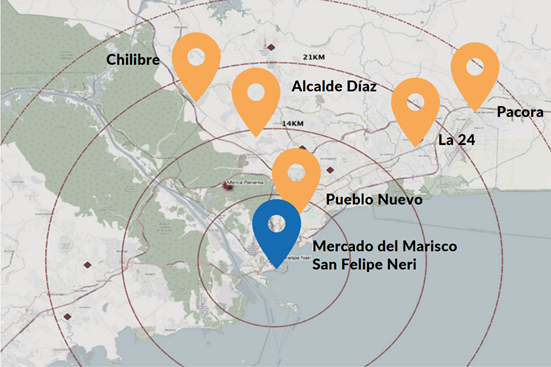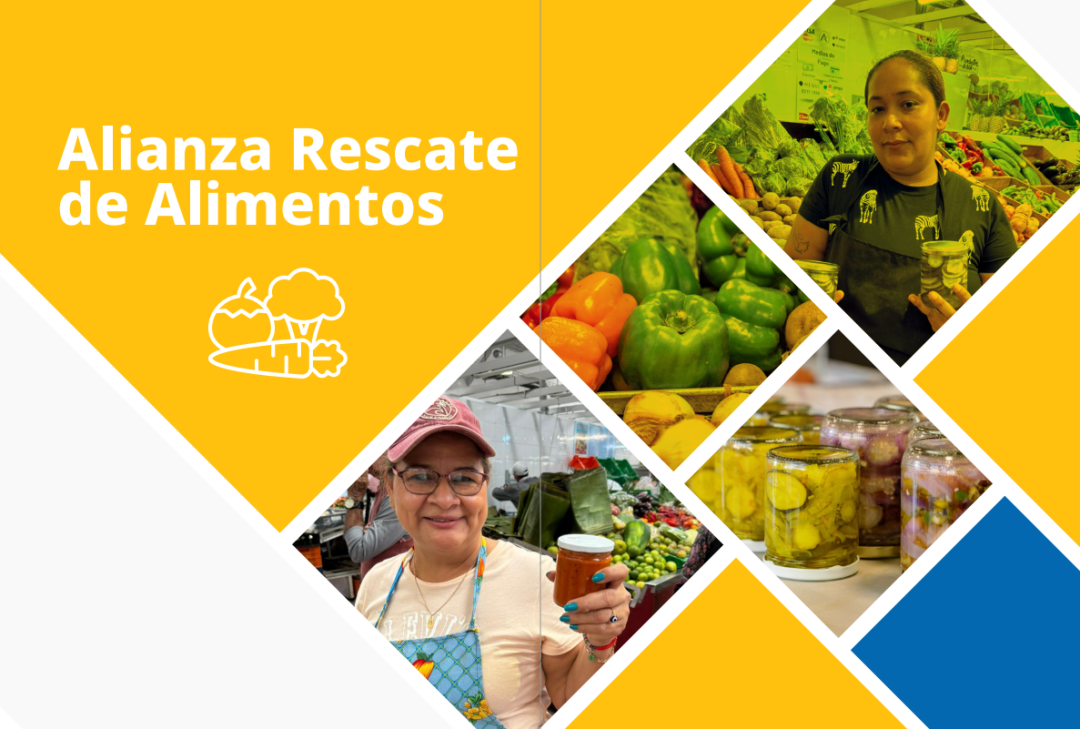Challenge statement
Challenge type: If you are working on multiple challenges, please indicate if this is your "big bet" or "exploratory" challenge.
Please note: we ask you to only submit a maximum of 3 challenges - 1x Big Bet, 2x Exploratory. Each challenge must be submitted individually.
EXPLORATORY
Challenge statement: What is your challenge? (Please answer in specific terms: "Our challenge is that...”.)
Markets are epicenters and living labs of cities and food systems, while also, in the case of Panama, are the third biggest generator of (mostly organic) waste. In the case of Panama City, the Municipal Network of Markets (RIMMU) also has the major challenge – and opportunity – to incorporate a transformative circular economy approach that reduces food waste, increases efficiencies in its operation and creates innovative governance models that accelerates change, with people at the center.
Background: What is the history of your challenge? What is causing or driving it? Who is involved? How does the current situation look like? What undesired effects does it produce?
Solid waste management (SWM) is one of the biggest issues of Panama and its effects are seen throughout the country, but specially in Panama City, where Cerro Patacón, the landfill of the Municipality of Panama (MUPA), is the tip of the iceberg of this systemic challenge. About 2,500 tons of waste are disposed at Cerro Patacón every day, coming from the 1.4 million inhabitants of the metropolitan area.
A key layer on this issue is that organic waste composes an average of 50% of all landfills in Panama (INECO, 2017). The global significance unveils the fact that food loss and waste account for 8-10% of greenhouse gas emissions and the necessity to curb their spreading in Panama. On the other hand, Panama also faces significant challenges in meeting SDG 2, which aims to eradicate hunger and malnutrition.
On this matter, according to the SOFI 2024 report, 5.6% of the population (200,000 people) lacks sufficient access to food. Diet-related noncommunicable diseases, such as obesity and hypertension, are prevalent, affecting 71.1% of adults. Current food systems impact both health and the environment, making it crucial for states to promote sustainability and nutrition.
If we include Merca Panamá, which is not part of the Municipal Network of Markets, but serves a the main supplier of these, the estimated generation goes up to 33.7 tons a day. This poses another challenge and opportunity in terms of integrating the markets to the local ecosystems of these diverse territories.
Therefore, network of municipal markets plays a key role by enabling access to fresh and nutritious food, promoting healthy eating habits, and reducing food loss and waste, while transitioning to circular models that put people at the center and becomes an enabler of local ecosystems.
The before mentioned transition highlights deeper needs, such as insufficient institutional capacity and the absence of an effective inter-institutional and inter-sectorial governance mechanism that make markets more sustainable, while at the same time underscoring severe disparities in waste management services that predominantly impact vulnerable groups like women, children, elderly people, or individuals with a disability.
There is great urgency now more than ever before that Panama accelerates its transition towards a circular economy model in its waste management systems. The recent experience through the municipal initiative Zero Waste is already proposing markets as ‘living labs’ for building circular economy practices with people at the center, the case of San Felipe Neri market is already creating traction and represents a starting point to expand and scale through the RIMMU.
Quantitative evidence: What (official) data sources do you have on this challenge that better exemplifies the importance and urgency of this frontier challenge? You can add text, a link, or a picture.
As mentioned in the previous section, organic waste composes about 50% of all the waste generated in Panama City (INECO, 2017), which represent about 8-10% of greenhouse gas emissions in the country. And markets are the third biggest generators of waste in Panama City. All of this while we also have 5.6% of the population in the country that does not have sufficient access to food and about 71% of the population with diet-related noncommunicable diseases, such as obesity and hypertension (SOFI, 2024). Climate change is also exacerbating the impacts the food security in Panama due to more severe dray and rainy seasons, which has represented about a 23% of food production loses.
This data is particularly relevant when we look at the distribution of the RIMMU, which has 4 operational markets in the periphery of Panama City, including the corregimientos of Santa Ana, Pueblo Nuevo, Alcalde Díaz and Pacora, with the last three being inaugurated between 2023-2024 and two more in construction (24 de Diciembre and Chilibre), all of which compose a population of more than 200,000 people and an estimated generation of 3.7 tons of food waste a day (for the 4 markets that are currently operating, without including the 2 that are under construction).

Qualitative evidence: What weak signals have you recently spotted that characterizes its urgency? Please provide qualitative information that better exemplifies the importance and urgency of this frontier challenge. You can add text, a link, or a picture.
Through our previous learning cycles, our main focus was to explore circularity opportunities at the San Felipe Neri Municipal Market, but we identified signals that the relevance of public markets seems to be decreasing within Panama City, supermarkets, delivery and other options seem to be gaining a territory to municipal public markets, but at the same time, markets continue to be a place of encounter and opportunity for more sustainable and resilient communities. These learning cycles were helpful in identifying opportunities to rethink these markets so that they continue to be epicenters of social cohesion and community action.
Some aspects we explored to catalyze circularity, included (i) governance sandboxes, (ii) food rescue initiatives articulating with local actors for redistribution, (iii) non-organic waste separation, (iv) the use of digitalization/financial inclusion of market vendors; and (v) the market as a public market that builds on the historical relationship of public markets with their peripherical communities. You can see more of the process to identitify these dynamics in the report Zero Waste Markets Initiative: Iniciativa Basura Cero, Mercado San Felipe Neri | Programa De Las Naciones Unidas Para El Desarrollo. And the summary of learnings from the experiments here: Resumen de Aprendizajes de Pilotos sobre Circularidad en Mercados Públicos | Programa De Las Naciones Unidas Para El Desarrollo

Value proposition: What added value or unique value proposition is your Accelerator Lab bringing to solving this challenge? Why is it your Lab that needs to work on this challenge and not other actors within UNDP, other stakeholders in the country respectively? Why is it worth investing resources to this challenge?
This new learning cycle "Sustainable Transformation of Municipal Markets in Panama: Circular Economy and Zero Waste" builds on the learnings of three previous learning cycles and UNDP Panama's portfolio on circular economy that will now be expanded from one market (San Felipe Neri) to the Municipal Market Network of Panama City through a joint project of UNDP with FAO.
The R&D capabilities of our Accelerator Lab will not only build on the continuous learnings that we have generated on this topic but will also deepen the understanding on how municipal/governance sandboxes can bring back markets to being epicenters of life in Panama City through circular economy models that foster social cohesion, solidarity and wellbeing in communities, with a gender approach.
Short “tweet” summary: We would like to tweet what you are working on, can you summarize your challenge in a maximum of 280 characters?
Markets are urban hubs and food system labs, with Panama's Municipal Markets being the third-largest source of organic waste. Learn more on how they are adopting a circular model that foster social cohesion, solidarity and wellbeing in communities, with people at the center.
Partners
Who are your top 5 partners for this challenge? Please submit from MOST to LEAST important and state Name, Sector and a brief description of the (intended) collaboration.
Please state the name of the partner:
Municipality of Panama
What sector does our partner belong to?
Government (&related)
Please provide a brief description of the collaboration.
The Municipality of Panama and the Municipal Network of Markets are the main counterpart for this project, with whom we have a broad range of actions as part of the circularity portfolio of UNDP in Panama, including the Zero Waste Markets initiative and the previous design and testing of circularity pilots at the San Felipe Neri Market.
Is this a new and unusual partner for UNDP?
No
Who are your top 5 partners for this challenge? Please submit from MOST to LEAST important and state Name, Sector and a brief description of the (intended) collaboration.
Please state the name of the partner:
FAO
What sector does our partner belong to?
United Nations
Please provide a brief description of the collaboration.
As a joint programme, UNDP is working together with FAO, in specific in the design of a governance model that enables circular models in the municipal network of markets, including MERCA, which is one of the main actors in the food systems value chain of Panama.
Is this a new and unusual partner for UNDP?
No
Learning questions
Learning question: What is your learning question for this challenge? What do you need to know or understand to work on your challenge statement?
how municipal/governance sandboxes can bring back markets to being epicenters of life in Panama City through circular economy models that foster social cohesion, solidarity and wellbeing in communities?
To what stage(s) in the learning cycle does your learning question relate?
Test, Grow
Usage of methods: Relating to your choice above, how will you use your methods & tools for this learning question? What value do these add in answering your learning question?
The center of our learning question is on regulatory sandboxes, we have already conducted a few sessions with the Municipal Market Network to understand the institutional barriers and opportunities to innovation for circularity models.
We will use this as a base to identify key areas there the current regulation (or gaps in the regulation) can enable innovation, or better said, we will create a sandbox to test how the municipality could innovate with their current regulatory landscape and what is needed to enable a circular model for the municipal network of markets.
This will be done not only looking through the regulatory lens, but we will also build on the solutions network for market circularity and expand the network to new partners from private sector, NGO, academia and civil society to build actionable collective intelligence, co-designing experiments and interventions with high potential to scale.
Existing data gaps: Relating to your choice above, what existing gaps in data or information do these new sources of data addressing? What value do these add in answering your learning question?
As described in the challenge statement, municipal markets have issues with their business model and limited institutional capacity to articulate a new value proposition on its own. This is why we will bring in a systemic approach to look into the current institutional regulations, but also into the business model data of the market as a municipal enterprise. We will identify the value people see in the market and how it could respond better to citizen needs through citizen generated data; and will use these insights to co-design with the previously mentioned network of solutions actionable collective intelligence to test and scale opportunities to make the markets epicenters of life and circularity in Panama City while improving their business model and sustainability, with people at the center.
Closing
Early leads to grow: Think about the possible grow phase for this challenge - who might benefit from your work on this challenge or who might be the champions in your country that you should inform or collaborate with early on to help you grow this challenge?
The Network of Municipal Markets is in expansion and the learnings of this process can generate a dynamic where markets become a place of wellbeing, community and discovery of new opportunities for sustainable communities. This model can be expanded to other Municipalities such as Arraijan, Chorrera or Colón, articulating alliances with other key actors such as MIDA, IMA, IDIAP and Cadena de Frío to strengthen food systems and value chains to reduce food waste before it reaches markets; as well as partnerships with private sector and agricultural producers for collaborations/investments in high potential food and circularity initiatives that could reduce food waste and support food security in Panama. For people and planet.
END OF ACTION LEARNING PLAN: Thank you! The form saves automatically and your submission has been recorded. You may now exit this window.


 11
11

 12Responsible consumption and production
12Responsible consumption and production 16Peace, justice and strong institutions
16Peace, justice and strong institutions
Comments
Log in to add a comment or reply.